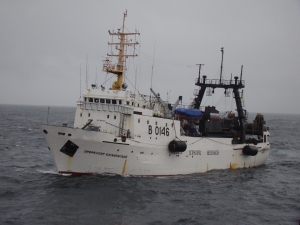
A report on an integrated survey performed by the Professor Kaganovsky research vessel in South Kuril area and in the Sea of Okhotsk in the spring of 2017 was presented in TINRO-Center. 434 observations at stations and more than 400 trawl hauls were performed in an area of more than 550,000 square kilometers.
In March – April, the survey focused on resources on the Pacific side of Kuril Islands. By words of Artem Sheibak, head of the expedition and TINRO-Center research fellow, individuals belonging to junior age groups dominated in the pollock stock structure on the Pacific side of the islands and percentage of commercial-size pollock individuals was low. The hydrological conditions and abundant feeding sources were favorable for pollock juveniles feeding.
The abundance of pollock older than one year in this area was estimated at 370 million individuals and 72,200 tons and its fishable stock was assessed at 53.9 million individuals and 29,300 tons. The number of yearlings was 2.8 billion individuals which is indicative that the 2016 year class is medium-strong. Roe surveys showed that roe distribution corresponded to spring periods of preceding years. Its main concentrations were observed in shallow waters (within 100 meters) while spawners themselves were observed mostly beyond the 100-meter depth contour in Ekaterina Strait and along Iturup Island till Kasatka Bay and south of Shikotan Island.
The second part of the study was performed in the Sea of Okhotsk. In April, scientists were monitoring the stock condition of pollock, herring, capelin and other nekton species off West Kamchatka. Pollock continues remaining the key nekton species in the northern part of the Sea of Okhotsk. According to trawling survey data, its total abundance was estimated at 55.7 billion individuals and 12.7 million tons. Its spawning stock was estimated at 14.5 billion individuals and 7.6 million tons. This means that the abundance and biomass of mature and immature pollock individuals grew 1.2 times during one year.
The surveys also showed that the number of yearlings was estimated at 6.4 billion individuals; therefore, the 2016 year class may also be considered a medium-strong one. Catches were dominated by individuals belonging to the strong 2013 year class and 4-year-old individuals accounted for at least one-third of pollock catches. In general, pollock stock condition in the northern part of the Sea of Okhotsk was assessed as good, and its size and age composition gives hope for favorable forecasts in the coming years.
Source: TINRO websitehttp://www.tinro-center.ru/home/novosti/ucenyeotmecautuveliceniecislennostimintaavsevernojcastiohotskogomora
